 Submitted by Henry on
Submitted by Henry on
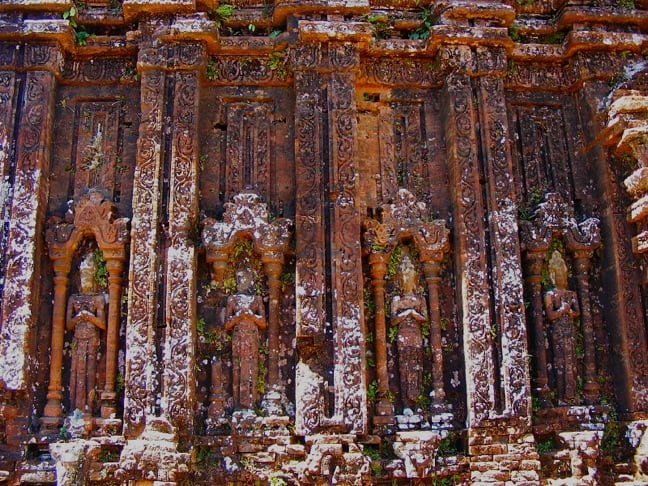
It’s a big world! Here are some fascinating current bits from the world of Archeology.
Early Image of Jesus Found in Egyptian Tomb
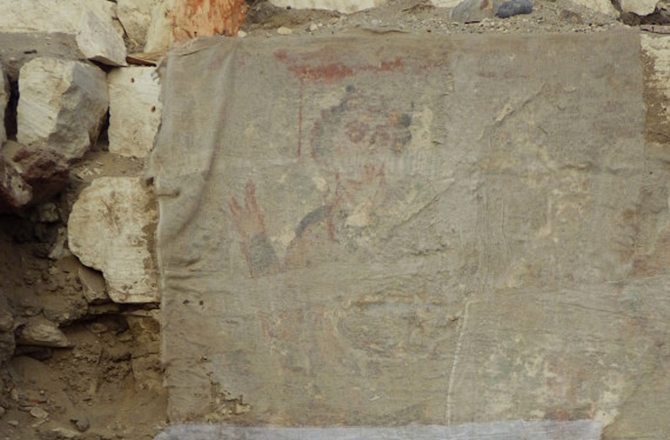
http://news.discovery.com/history/archaeology/early-image-of-jesus-found-in-egyptian-tomb-140430.htm
Spanish archaeologists have discovered what may be one of the earliest depictions of Jesus in an ancient Egyptian tomb.
Painted on the walls of a mysterious underground stone structure in the ancient Egyptian city of Oxyrhynchus, about 100 miles south of Cairo, the image shows a young man with curly hair and dressed in a short tunic.
“He raises his hand as if making a blessing,” said Egyptologist Josep Padró, who has spent over 20 years excavating sites in the area.
In this expedition, he led a team of archaeologists from the University of Barcelona, the Catalan Egyptology Society and the University of Montpellier.
“We could be dealing with a very early image of Jesus Christ,” Padró added.
Oxyrhynchus is known for the worship of the Egyptian god of the afterlife Osiris: indeed the underground structure was located in the middle of a processional route that joins the Nile with the Osireion, the temple dedicated to Osiris.
But the painting is from much later, dating from between the sixth and seventh century A.D.
To get to the underground chamber, Padró’s team removed over 45 tons of stones.
Finally, the archaeologists reached a rectangular crypt measuring about 26 feet long and 12 feet deep. They are unsure what the function of the structure was originally, but believe it might have possibly been another temple dedicated to Osiris.
Once inside, the archaeologists found five or six coats of paint on the walls, the last of which was from the Coptic period of the first Christians.
In addition to the image of the curly man, the walls feature symbols and images of plants and inscriptions written in the Coptic language, which are currently being translated.
“In order to carry out future campaigns, it is necessary to excavate an attached structure. A flight of well worn stairs give access to it, but researchers do not know its content yet,” the University of Barcelona said in a statement.
Cold War-Era Satellite Images Reveal Lost Cities
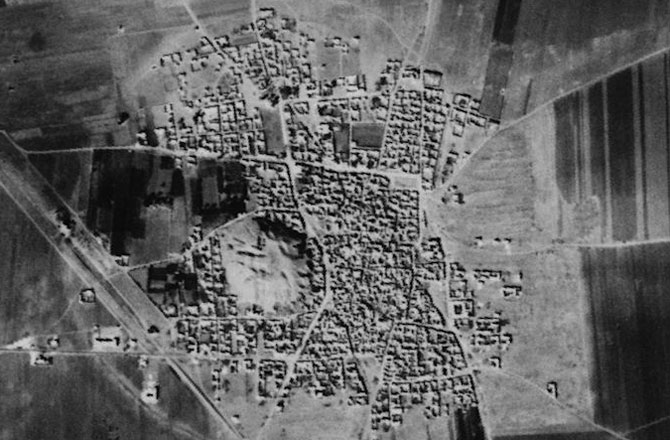
by Amanda Onion
Cold War-era spying apparently yielded more than state secrets. New analysis of satellite images from the Middle East has revealed a bevy of previously unknown ruins in the forms of ancient roads, cities and canals in a region spanning from Egypt to Iran -- and encompassing the Fertile Crescent.
As detailed by Dan Vergano in National Geographic, a team from the University of Arkansas explored declassified images snapped during a 12-year U.S. spy satellite mission codenamed CORONA. The mission, which operated between 1960 and 1972, was intended to expose Soviet missile bases and military camps with a resolution of two meters (6.6 feet).
The satellite images are grainier than satellite pictures taken with today's technology, but timing is everything. Since the 188,000 photos were taken before much major development took hold in the region, signs of the ancient civilizations are still evident in the images.
As University of Arkansas archaeologist Jesse Casana told National Geographic, "we can't see a site that someone has covered up with a building."
Among the largest sites detected in the imagery are what appear to be Bronze Age cities in Syria and Turkey, as evidenced by ruins of walls and citadels. Casana estimates at least two of these ancient cities are "gigantic," covering more than 123 acres.
The photos offer a wealth of information to archaeologists studying the region. The University of Arkansas team began their investigations with a list of 4,500 known archaeological sites in the Middle East. The photographs, which were declassified in 1992, have yielded an additional 10,000 previously unknown sites.
All this comes from a program that had operated under utmost secrecy. According to the National Geographic report, film from the spy satellites was delivered from space via parachute-equipped buckets.
And there's more where these images came from. The CORONA program operated beyond the Middle East, also exploring regions in Africa and China. Archaeologists are now eager to investigate images from those regions in the hopes of finding further archaeological sites that have since been obscured by irrigation projects and expanding modern cities.
As Casan said, "We don't want to stop here."
'Vampire' Skeleton Unearthed in Poland
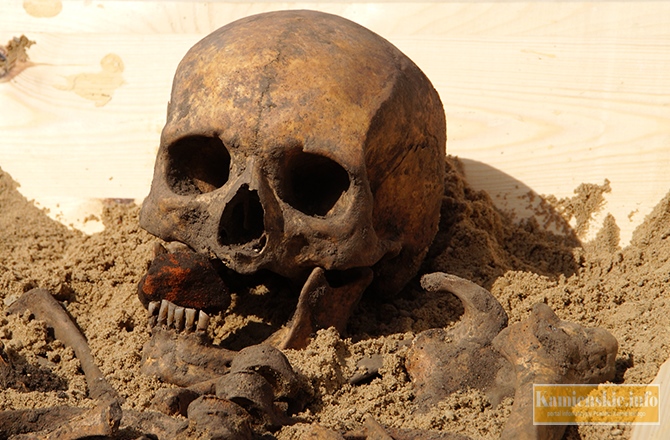
http://news.discovery.com/history/archaeology/vampire-skeleton-unearthed-in-poland-14050.htm
Archaeologists in Poland say they have discovered a skeleton with a brick stuck into the mouth — evidence that the subject was believed to be a vampire.
Dated to the 16th-17th century, the grave was unearthed during excavations in the town of Kamien Pomorski, in northwestern Poland, the Kamienskie.info website reported.
In addition to the brick, which was wedged so violently into the mouth to knock out the upper teeth, the skeleton featured a leg with a hole likely made from a puncture. This would suggest the leg had been staked to the ground to prevent the individual from rising from its grave.
“A piece of debris brick in the mouth and a pierced thigh indicate this is a vampiric burial,” Slawomir Gorka, the archaeologist who led the dig, said.
People feared that those accused to be vampires would rise from their graves like zombies. In some cases, to kill the undead creatures, they placed a stone or brick into the mouth so that the vampire would starve to death.
According to Gorka, such vampire-slaying rituals were common in local graves between the 13th and 17th centuries.
Indeed, it’s not the first time that “deviant burials” have been unearthed in Poland and across eastern Europe.
Last year, Polish archaeologists found a grave near the town of Gliwice filled with skeletons whose severed heads were placed atop their legs.
Such burials appear to be common in Slavic regions for people accused of vampirism, although alternative hypothesis suggested the skeletons were simply victims of an execution.
Deviant burials are often linked to Black Death-related cemeteries and to medieval ignorance of how diseases spread.
Mass graves were often reopened to bury corpses during epidemics, exposing bloated bodies with blood seeping out of the mouth and with a hole in the shroud used to cover their face.
Medieval people, not knowing what happens to bodies after death, believed that “vampire” individuals spread the plague by chewing on their shrouds after dying.
In a time before germ theory, the stone in the mouth was then used as a disease-blocking trick.
Nine Unopened Dead Sea Scrolls Found
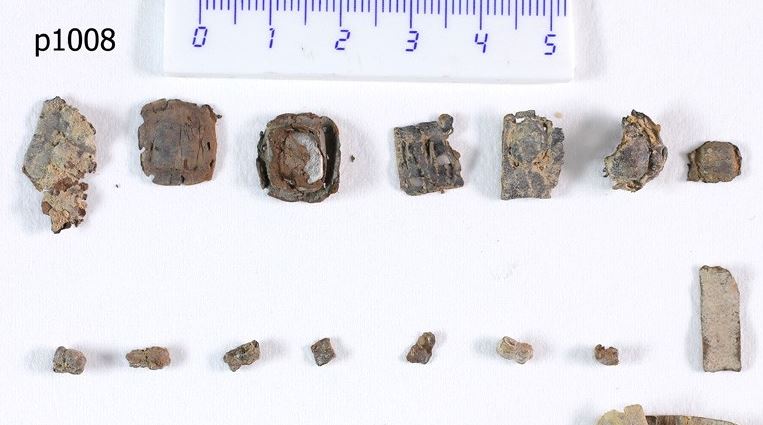
http://news.discovery.com/history/archaeology/nine-unopened-dead-sea-scrolls-found-140313.htm
Nine newly found penny-sized pieces of parchment belonging to the Dead Sea Scrolls laid unopened for nearly six decades before they were rediscovered in Israel.
The scrolls went unnoticed for years until one scholar came across them while searching through the Israel Antiquities Authority's (IAA) storerooms, the Times of Israel reported.
"Either they didn't realize that these were also scrolls, or they didn't know how to open them," the IAA's head of artifact treatment and conservation Pnina Shor explained.
The tiny scrolls were found inside three phylacteries, small leather boxes with Biblical versus written on them (called tefillin) that are worn by Jews during their morning prayers. Their discoverer, Yonatan Adler, had the boxes scanned by CT at a hospital in Israel in hopes there would be parchment inside.
He was right.
Once unopened, the scrolls are expected to shed new light on the religious practices of the Jewish people during the Second Temple Period between the years of 530 BC and 70, an era named for a holy place of worship for the Jewish people that was constructed by the builder of ancient Jerusalem King Herod. The Dome of the Rock stands today where the Second Temple purportedly once stood.
At least two dozen phylactery scrolls were discovered in the 1940s and 50 along with the rest of the Dead Sea Scrolls in a limestone cave in the West Bank's Qumran in Israel.
" found a number of fragments of tefillin cases from Qumran Cave 4, together with seven rolled-up slips," Adler told the Times of Israel.
Until now, the scrolls remained bound inside the phylacteries for approximately 2,000 years.
The IAA has been tasked with the difficult job of unrolling the scrolls without damaging them.
"We're going to do it slowly, but we'll first consult with all of our experts about how to go about this," said Schor, who would not reveal when the process would start. "We need to do a lot of research before we start doing this."
Remains of more than 900 religious manuscripts were found in 11 caves near the Dead Sea in the 1940s and 50s in Qumran.
FoxNews, all rights reserved.
Bones in Submerged Cave May Be Earliest Native American
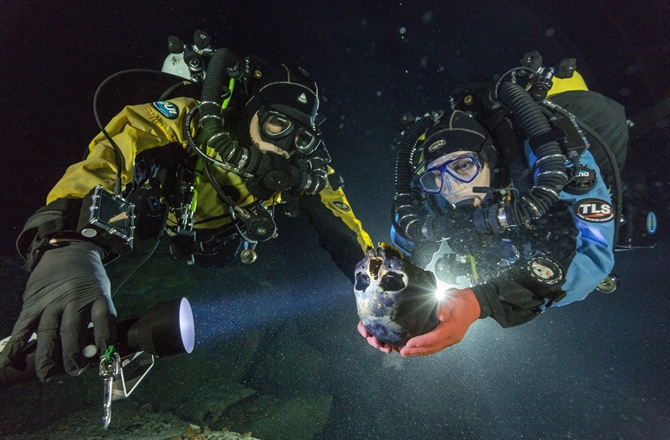
Divers mapping the underwater caves within Mexico's Eastern Yucatan Peninsula came upon a surprising find -- a superbly preserved skeleton dating close to the time when people first entered the New World.
"It was like a magnet and I remember swimming over to her remains and hovering in place about 12 inches from the skull, absolutely spellbound, for several moments," Susan Bird, a Bay Area Underwater Explorers diver, told Discovery News.
Subsequent underwater testing and analysis of this oldest, most complete skeleton found in the Americas has since provided evidence that modern Native Americans are directly related to the earliest inhabitants of the Americas, according to a study published today in the journal Science.
Dating close to the time when people first entered the New World, the early American, or Paleoamerican, skeleton features Native American DNA while showing a distinctly different skull shape. The research provides new clues to how the Americas were first populated.
It suggests the morphological differences between Paleoamericans, the first people to inhabit the Americas after the most recent ice age, and modern Native Americans are not the result of separate migrations from southeast Asia or even Europe. Rather, they belong to the same population that "evolved in place" in the Americas and Beringia, a now partially submerged landmass including parts of Siberia, Alaska and the Yukon.
Belonging to an adolescent girl, the skeleton was found in 2007 in a submerged chamber named Hoyo Negro (Spanish for Black Hole), deep inside a cave system on Mexico's Eastern Yucatán Peninsula, about 12 miles north of the city of Tulum.
"The moment we entered the site, we knew it was an incredible place. The floor disappeared under us, and we could not see across to the other side. We pointed our lights down and to the sides. All we could see was darkness," Alberto Nava of Bay Area Underwater Explorers, one of the divers who found the skeleton, told Discovery News.
About two months later, armed with powerful underwater lights, the divers reached the floor of the pit at about 170 feet. They found themselves in a bell-shaped structure 200 feet in diameter, whose center was littered with large boulders stacked on top of each other.
"As our eyes got accustomed to the environment, we started to notice large animal bones resting at the bottom and on the walls of the pit," Nava said.
Then one of the divers spotted a human skull resting on the top of a small ledge. The small cranium lay upside down and rested on the left humerus (upper arm bone) with other remains nearby.
"It had a perfect set of teeth and dark eye sockets looking back at us. We could see the rest of the upper torso spread to the left and down on the ledge," Nava said
Using photography, videography, three dimensional modeling and minimal sampling, researchers studied the skeleton without removing it from its watery grave. Only recently, due to unauthorized dives risking to damage the remains, the skull and other four bones were recovered and placed in an artifact conservation lab in Campeche, Mexico.
The international team of anthropologists, archaeologists, geneticists, and geologists was led by anthropologist James Chatters, owner of Applied Paleoscience, a consulting service in Bothell, Wash. He was the first to study Kennewick Man, a 9,300-year-old skeleton found in Washington in 1996.
Also showing the distinctive Paleoamerican rather than modern Native American traits, the Kennewick skeleton triggered a nine-year legal battle between scientists, the U.S. government and Native American tribes who claimed him as one of their ancestors and sought permission for reburial.
In 2004, a U.S. court ruling established there was no evidence connecting Kennewick Man with any existing tribe because the remains date back before recorded history and no cultural or biological link could reasonably be made.
The Hoyo Negro skeleton, which might reopen the debate, turned out to be much older than Kennewick Man.
"The skeleton produced the earliest radiocarbon age, confirmed in two separate laboratories, of any on the Americas," Chatters told Discovery News.
Indeed the human remains were dated between 12,700 and 12,900 years old.
"However, because the material we had to use for the age is one that is not entirely safe from contamination by old carbon in the rocks, we are being more conservative and giving the age as between 13,000 and 12,000 years," Chatters added.
- 882 reads